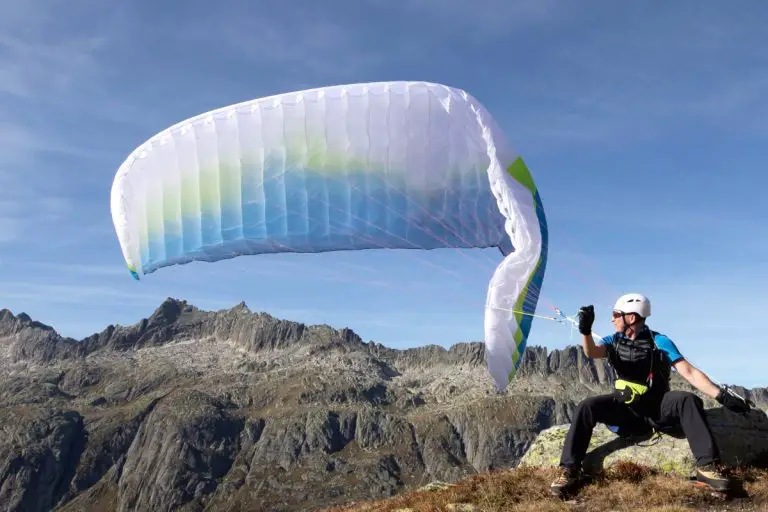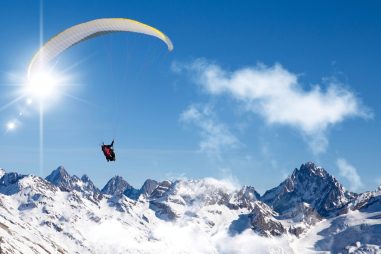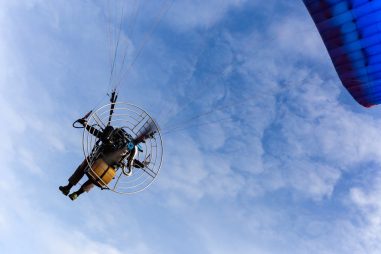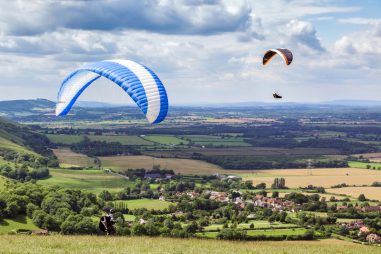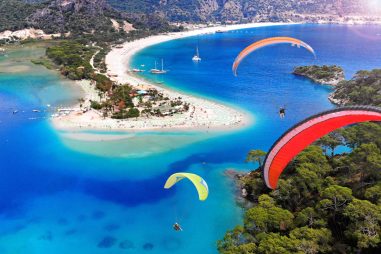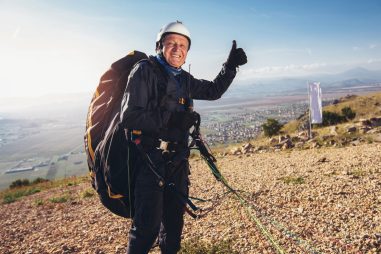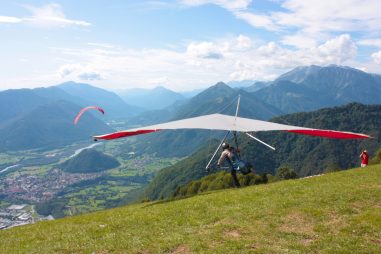As paragliding is an extreme sport, it does demand some physical and mental fitness. Fitness will help you in a lot of aspects in paragliding. Your fitness will also build up as you train so if you’re not fit prior to training, there’s no need to worry. Your weight is also a critical point in doing the sport. You cannot be over the weight limit and at the same time, not be below it. Weight can contribute to how you control your wing and how safe you are when flying.
Is Paragliding Physically Demanding?
One of the misconceptions about paragliding is that it is very physically demanding. While physical fitness is somewhat of a necessity, almost anyone can paraglide. There is only minimal physical activity when paragliding—excluding launching and landing.
There are different techniques involved in launching and landing. Since you need to do the right techniques and run a fair amount of meters, this will be what’s going to take up your energy. You are going to spend the majority of your time enjoying the view, so physical demand won’t be too high in mid-air.
Do You Need to Be Strong to Paraglide?
One of the most challenging parts of paragliding is controlling your wing. You’d have to prepare for winds that are stronger and learn how to navigate your direction. This may seem to be hard for the majority of people. But lucky for you, paragliding requires very minimal physical abilities.
The only aspects that will take up a bit of your energy would be the launching and landing. Both of these would be easier as you practice paragliding as much as you can. The time that you train will also help you in building strength to paraglide with ease.
Does Paragliding Make You Nauseous?
If you are someone who gets airsick, you might experience nausea for your first few flights. You may also experience anxiety or hyperventilation when you’re not used to paragliding. It’s a good thing that these concerns decrease as you practice more. Your body will gradually get familiarized as you take more flights.
Ensure that you take it slow. It is best to choose quieter and calmer conditions for your flight. Having quiet and calm conditions will help you manage nausea better. You should also consider taking medication preflight to help lessen your nausea.
Does Paragliding Cause Motion Sickness?
The majority of the complaints from first-time flyers is motion sickness. This is especially experienced by people who get carsick. This can make you feel queasy, dizzy, nauseous, or sick to your stomach while mid-air or after your flight. This might also cause some vomiting.
If you are prone to motion sickness, you should take medication before your flight. You should avoid paragliding in turbulent conditions. It is also best for you to not take wide turns or use techniques that may contribute to your condition. As you take more flights, motion sickness does tend to decrease.
Do You Have to Be a Certain Weight to Paraglide?
In paragliding, it is very important to be aware of how much you weigh. It is also advisable to know how much your equipment weighs. Knowing these weights is imperative for your safety. Not paying attention to details like this might cause several problems.
The weight range for paragliding depends on your paraglider. Before buying any equipment, make sure that you note how much they weigh. Knowing this will help you gauge how much your paraglider can carry. Ensure that you take your weight before buying your equipment so you can choose the better fit.
Is There a Weight Restriction for Paragliding?
Yes, there are weight restrictions in paragliding, especially for solo flights. These are in place to ensure that you are safe for each flight. Not being attentive to how much you load your paraglider may lead to accidents.
Weight restrictions will depend on how much your equipment can carry. Make sure that when you buy a wing, you know its weight. You would also have to account for your harness, clothes, and other equipment you take. It’s best to weigh yourself to ensure the precise number as well. You’ll need to add all these factors to determine if you are within the recommended weight to fly.
What Is the Weight Limit for Paragliding?
The weight limit for paragliding would depend on the size of your wing. The bigger your wing is, the higher the weight limit. Different manufacturers or producers of wings may have different sizing. Some extra-large paragliders are able to support up to 120 kilograms (265 lbs) for a solo flight. It is best for you to always ask the weight a wing can carry when buying one.
It is very important for you to know how much you weigh when you are paragliding. You should also be aware of how much your equipment weighs and how much it can carry. Knowing these numbers will help you lessen accidents such as overloading.
Can an Overweight Person Do Paragliding?
As stated, the weight limit for paragliding would depend on your wing. Being overweight should not be a big hindrance in paragliding if you know what to buy. It is a matter of choosing the correct wing.
If you are on the heavier side of the scale, it is advisable to buy a bigger wing. If you are higher than 180 kilograms (397 lbs), you might want to consider a paraglider used for tandem flights. The main thing that you want to avoid is overloading. Once you overload the capacity of your paraglider, you are prone to accidents. Some of the problems you might encounter include:
- Take-Off Difficulty: Overloading your paraglider would be difficult once you take off. If the wind isn’t too strong, the glider might not even make it off the ground. This will also cause the glider to drop off shortly after liftoff.
- Mid-Flight Dropoff: Wind helps in staying for longer while mid-air. This will be difficult if you overload. While a high enough paraglider might recover when the wind stops, this may not be the same with a low flying one. If the wind stops while mid-air, you will likely drop off.
- Crash Landing: This is one of the major concerns once you overload. Not accounting for the weight of your equipment and yourself increases crash landings. Due to the heavy load, your landing will prove to be difficult and may lead to injuries.
What Is the Minimum Weight for Paragliding?
The minimum weight for paragliding is also determined by the size of your wing. If you are petite, it is best to get a smaller-sized paraglider. The smallest paraglider is able to carry 55 to 75 kilograms (121 to 165 lbs). Being under the minimum weight may also lead to risks such as wing collapses and less control.
While being over the weight limit is bad; being under the weight limit is the same. Like overloading, underloading will also cause problems when you are paragliding. Be sure that you are aware of the minimum weight capacity of the wing you are going to buy.
What Is the Best Weight Range for a Paraglider?
It is very important for you to know what size of paraglider you should be using. Having a paraglider that is not the best fit for you will lead to difficulties while mid-air. Not being aware of how much your paraglider can carry may also lead to injuries.
Keep in mind that different producers or manufacturers have different sizing. The typical sizing is:
- Extra Small (XS): 55 to 75 kilograms (121 to 165 lbs)
- Small (S): 65 to 85 kilograms (143 to 187 lbs)
- Medium-Small (MS): 75 to 95 kilograms (165 to 210 lbs)
- Medium-Large (ML): 90 to 110 kilograms (198 to 243 lbs)
- Large (L): 105 to 130 kilograms (231 to 287 lbs)
- Tandem Paragliders: Up to 240 kilograms (529 lbs)
Hop on a scale before buying one and make sure to take into account other equipment. Also, remember to give a bit of allowance especially when you are planning longer flights. Ensure that you consider the weight of additional equipment and water for drinking.
How Do You Calculate the Weight of a Paraglider?
The easiest way to calculate this is to step on the scale with your paragliding rucksack. You need to load it with all your gear like you are going for a flight. Once you see the number on the scale, subtract your own body weight. This method will determine how much your paraglider weighs.
It is imperative to choose a wing that would have your weight range on the top half. The best percentage is 75%. If your wing can carry between 90 to 110 kilograms (198 to 243 lbs), your ideal total weight for take-off would be 100 to 105 kilograms (220 to 232 lbs). This should include the weight of your equipment and yourself.
Can You Go Paragliding When Pregnant?
Some companies may allow pregnant women to do tandem flights up to their 2nd trimester. Professional paragliders will also often go for a flight when they are pregnant. However, if you’re a beginner, this is not advisable.
Risks can double when you are pregnant. Since pregnancy is a sensitive stage, there are activities that are not advisable. You are also more prone to motion sickness when you are pregnant. This may lead to injuries not only to you but also to your baby.
Is Paragliding Safe During Pregnancy?
As with any activity, safety should be your utmost priority. When you’re pregnant, you’d have to also consider another life growing inside you. Pregnancy entails a lot of precaution.
While paragliding is one of the safest extreme sports, it is not advisable when you’re pregnant. The risks of paragliding while you’re pregnant include:
- Exhaustion: You need to exert effort and energy when you launch. Navigating your gear while windy would also take up a bit of effort. If you are also paragliding on a hot summer’s day, you might experience over-heat.
- Motion Sickness: When you are pregnant, you are more prone to nausea. If experienced mid-flight, you would have difficulty controlling your paraglider. This might result in injuries, especially for beginners.
- Dangerous Landing: Doctors are often opposed to doing activities that involve high impact. If you have a bad landing, this might lead to injuries to your baby.
Is Paragliding Good for Your Health?
Aside from being a fun activity, paragliding is also good for your physical and mental health. The training period alone can help you be fit. The mere fact of being outdoors and moving is already good for your health.
Paragliding adds a layer of excitement to this which is also good for your mental health. It helps you with your focus and it allows you to be mindful of your abilities and your surroundings.
What Are the Benefits of Paragliding?
There are heaps of benefits that paragliding can give you. Soaring through the sky and basking in the view beneath already gives you a boost of serotonin. Not to mention the physical health benefits you would also get.
Here are the top health benefits of paragliding:
- Adrenaline Rush: Being high up in the sky and admiring the view atop gives you a certain type of excitement. This rush of adrenaline provides a surge of energy that helps boost your serotonin.
- Being Outdoors: Being outdoors is already healthy in itself. You get to have fresh air, be in the sunlight, and be exposed to nature. These all contribute to a boost in your immune system, especially the vitamin D you get from sunlight.
- Stress Relief: When you are paragliding, you only focus on the sport itself. This means that your concentration is in the present. This makes you forget the stresses of the past and worry about the future. It gives you that zen boost that you need to relax and be stress-free.
- Upper Body Strength: Your upper body strength would build up as you train and do the sport often. With this, you would have better control of your paraglider. This will also provide you with stronger muscles in your arms.
- Body Balance: Paragliding helps you build a strong core as it engages your core muscles. This in turn helps you with your posture, balance, and stability.
- Burns Calories: Paragliding can also be a great workout. You would burn around 230 calories an hour through paragliding. This is because of the running during launching and engaging your core mid-flight.
- Confidence Boost: Piloting your first flight would for sure make you ecstatic. On top of that, you would get a sense of accomplishment each time you complete a flight.
- Conquering Your Fears: Paragliding gives you the opportunity to face your fears head-on. Be it fear of heights, flying, or vast spaces, paragliding will help you overcome this. You will come out proving to yourself that you are better than your fears.
- Wonderful Views: When you are hundreds or thousands of feet above the earth, you get a great view of the land. You will see majestic sights and admire the breathtaking view of this planet.
- Freedom: Everyone wants to feel that sense of being completely free. Be it from stress, anxiety, or even everyday work. Paragliding gives you just that. Freedom from all your worries and freedom to be with yourself, thousands of feet from the ground, and looking over an amazing view.
Paragliding, as shown above, is very good for your health. It improves both your physical and mental health. It contributes to having a huge spike in serotonin. It also helps you build up your strength and improve your fitness. Remember to enjoy your flights and be safe.

